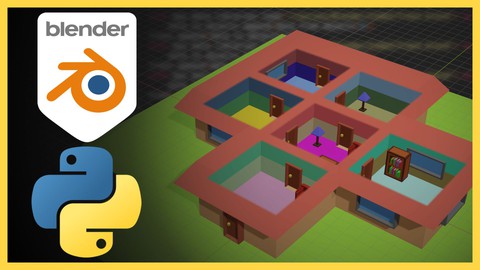
Procedurally generated house with Blender & Python
Procedurally generated house with Blender & Python, available at $44.99, has an average rating of 3.5, with 66 lectures, based on 1 reviews, and has 30 subscribers.
You will learn about Use the scripting section in Blender to create a procedurally generated scene. Use Object Oriented Programming with python and use it as helping tool to design models Import external models in blender with python Use of linked lists and recursive operations Use NumPy and PyPlot to plot points in a cartesian plane Export the scene to use it in Godot This course is ideal for individuals who are 3D designers or programmers who want to automate tasks to create complex 3D scenes. It is particularly useful for 3D designers or programmers who want to automate tasks to create complex 3D scenes.
Enroll now: Procedurally generated house with Blender & Python
Summary
Title: Procedurally generated house with Blender & Python
Price: $44.99
Average Rating: 3.5
Number of Lectures: 66
Number of Published Lectures: 66
Number of Curriculum Items: 66
Number of Published Curriculum Objects: 66
Original Price: $59.99
Quality Status: approved
Status: Live
What You Will Learn
- Use the scripting section in Blender to create a procedurally generated scene.
- Use Object Oriented Programming with python and use it as helping tool to design models
- Import external models in blender with python
- Use of linked lists and recursive operations
- Use NumPy and PyPlot to plot points in a cartesian plane
- Export the scene to use it in Godot
Who Should Attend
- 3D designers or programmers who want to automate tasks to create complex 3D scenes.
Target Audiences
- 3D designers or programmers who want to automate tasks to create complex 3D scenes.
Hello and welcome.
If you are a designer or developer who is interested in creating scenes automatically with unique features and the ability to use them in an external application, this course is for you.
This course focuses on creating multiple Python scripts that will help us create a house with a multiple number of rooms in it.
For this, we will use Blender and its scripting section where we will use Python.
With python, we will use basic elements of object-oriented programming to help us create a linked list that we will use as a basis for creating multiple objects that will represent the rooms.
Each of the rooms will contain enough information for us to obtain the coordinates and routes to plot a house.
This course may be attractive to you because it can help you save time when you are designing scenes with the ability to add your custom elements to the script.
In addition, you will have access to the content created during the course.
I hope you find the content useful and that you can apply it to your personal projects.
Have fun and happy learning.
In this course you will learn:
-
Use the scripting section in Blender to create a procedurally generated scene.
-
Use Object Oriented Programming with python and use it as helping tool to design models.
-
Import external models in blender with python.
-
Use of linked lists and recursive operations.
-
Use NumPy and PyPlot to plot points in a cartesian plane.
-
Export the scene to use it in Godot.
You will require:
-
Blender 3.X.
-
Be familiar with Python or basic programing. You can follow the videos if you don’t have any experience.
-
Optionally Godot to import the Blender scene.
Course Curriculum
Chapter 1: Introduction
Lecture 1: Introduction
Lecture 2: Classes and objects
Lecture 3: Linked list
Lecture 4: Recursion
Lecture 5: Defining the class
Lecture 6: Implementing linked list
Lecture 7: Implementing traverse
Lecture 8: Implementing find
Lecture 9: Add function customization
Lecture 10: Implementing the Class. Pt 1
Lecture 11: Implementing the Class. Pt 2
Lecture 12: Using PyPlot
Lecture 13: Plotting the rooms
Lecture 14: Preparing the code for Blender
Lecture 15: Implementing the code in Blender
Chapter 2: Room class
Lecture 1: Defining the Room class
Lecture 2: Create New Instance
Lecture 3: Constants values
Lecture 4: Implementing add function
Lecture 5: Customizing the add function
Lecture 6: Connecting the rooms. Pt 1
Lecture 7: Connecting the rooms. Pt 2
Lecture 8: Cardinal directions
Chapter 3: House class
Lecture 1: Defining the House class
Lecture 2: Using iterators
Lecture 3: Building the rooms
Lecture 4: Constants values
Lecture 5: Entrance and exit. pt 1
Lecture 6: Entrance and exit. pt 2
Lecture 7: Entrance and exit. pt 3
Lecture 8: Misc functions
Lecture 9: Entrance and exit doors
Chapter 4: Plotting with PyPlot
Lecture 1: Implementing the house with Pyplot
Lecture 2: Plotting the house
Chapter 5: Code into blender
Lecture 1: Preparing the code for Blender
Lecture 2: Importing external figures
Lecture 3: Random material and empty figure
Lecture 4: Implementing the house class
Lecture 5: Getting boundbox size
Lecture 6: Inserting the rooms
Lecture 7: Grouping into one figure
Lecture 8: Implementing the code in blender
Chapter 6: Implementing details
Lecture 1: Outside ground
Lecture 2: Implementing ground code
Lecture 3: Roof – Ceiling
Lecture 4: Implementing roof code
Lecture 5: Doors and windows
Lecture 6: Implementing doors and windows code
Chapter 7: Working with bmesh
Lecture 1: Boolean mod
Lecture 2: Implementing boolean mod
Lecture 3: Furniture
Lecture 4: Implementing furniture code
Lecture 5: Solidify and bevel mod
Lecture 6: Implementing solidify and bevel mod
Chapter 8: Code performance
Lecture 1: Performance test. Pt 1
Lecture 2: Performance test. Pt 2
Lecture 3: Performance test. Pt 3
Lecture 4: Performance test. Pt 4
Chapter 9: Exporting
Lecture 1: Exporting to glTF 2.0
Chapter 10: Extra. Godot
Lecture 1: Importing the model
Lecture 2: Adding the physics
Lecture 3: Adding the player
Lecture 4: Testing
Lecture 5: First person view
Chapter 11: Extra. Godot Performance
Lecture 1: Performance test. 900 Rooms
Chapter 12: End
Lecture 1: Final message
Instructors
-
Oscar Villarreal
Software developer
Rating Distribution
- 1 stars: 0 votes
- 2 stars: 0 votes
- 3 stars: 1 votes
- 4 stars: 0 votes
- 5 stars: 0 votes
Frequently Asked Questions
How long do I have access to the course materials?
You can view and review the lecture materials indefinitely, like an on-demand channel.
Can I take my courses with me wherever I go?
Definitely! If you have an internet connection, courses on Udemy are available on any device at any time. If you don’t have an internet connection, some instructors also let their students download course lectures. That’s up to the instructor though, so make sure you get on their good side!
You may also like
- Best Video Editing Courses to Learn in February 2025
- Best Music Production Courses to Learn in February 2025
- Best Animation Courses to Learn in February 2025
- Best Digital Illustration Courses to Learn in February 2025
- Best Renewable Energy Courses to Learn in February 2025
- Best Sustainable Living Courses to Learn in February 2025
- Best Ethical AI Courses to Learn in February 2025
- Best Cybersecurity Fundamentals Courses to Learn in February 2025
- Best Smart Home Technology Courses to Learn in February 2025
- Best Holistic Health Courses to Learn in February 2025
- Best Nutrition And Diet Planning Courses to Learn in February 2025
- Best Yoga Instruction Courses to Learn in February 2025
- Best Stress Management Courses to Learn in February 2025
- Best Mindfulness Meditation Courses to Learn in February 2025
- Best Life Coaching Courses to Learn in February 2025
- Best Career Development Courses to Learn in February 2025
- Best Relationship Building Courses to Learn in February 2025
- Best Parenting Skills Courses to Learn in February 2025
- Best Home Improvement Courses to Learn in February 2025
- Best Gardening Courses to Learn in February 2025






















